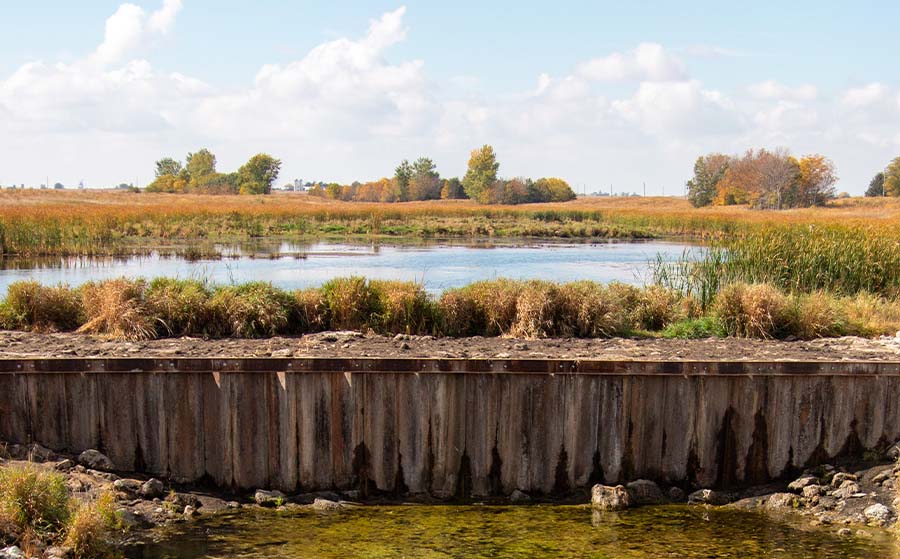
(Photo: Joclyn Bushman/Iowa Soybean Association)
ACWA Marks Nutrient Reduction Strategy Anniversary
February 9, 2023
The 10-year anniversary of the Iowa Nutrient Reduction Strategy is drawing near, and there are plenty of success stories about farmers protecting waterways and water sources.
But if you ask Roger Wolf, those efforts began well before 2013, when the strategy officially got under way.
Historical perspective
Wolf, executive director of Agriculture’s Clean Water Alliance (ACWA), says work on nutrient reduction began in earnest 20 to 30 years ago. ACWA, the Iowa Soybean Association (ISA), Iowa State University (ISU) and other organizations and entities have had a long history of taking action to address water quality concerns.
“Sometimes, I don’t think people recognize the prelude that went into the nutrient reduction strategy,” Wolf says.
Agricultural retailers, though in direct competition, united in the goal of improving and protecting water quality through the creation of ACWA in 1999. The members formed a 501(c)3, and went to work in the Raccoon River and Des Moines River watersheds.
Members have been focused on long-term implications on source water issues, nitrate removal and various practices that improve water quality.
Concurrently, the Mississippi River/Gulf of Mexico Hypoxia Task Force was created. At the time, Patty Judge, Iowa’s Secretary of Agriculture, was part of this task force, which came up with an action plan.
“Around 2012, some of us met with the agencies, and ISU was articulating its science assessment – explaining various scenarios of practice adoption, associated costs and opportunities,” Wolf says.
At that time, there was a convergence with business and industry, municipalities and others about coming together with agriculture to begin working on a strategy.
This coincided with the U.S. Environmental Protection Agency’s (EPA) efforts, beginning with a framework that encouraged states, EPA and stakeholders to work in partnership to accelerate the reduction of nitrogen and phosphorus loading in the nation’s waters.
The memo included elements that would be part of the nutrient reduction strategy with themes of implementation using robust scientific information.
Building bridges
ACWA, Wolf says, built bridges of cooperation between co-ops, ag retailers and farmers to work on water quality while also continuing practices that enabled farmers to be productive and profitable.
“ACWA was collecting data on nitrogen loss and its impact on the water, providing guidance on where to start working in the watershed,” he says. “This was way before the Iowa Nutrient Reduction Strategy was implemented.”
These efforts also shined a spotlight on ag retailers coming together to do a “little bit of self-policing and taking accountability,” Wolf says.
ACWA’s work along with the nutrient reduction strategy is a testament to protecting Iowa’s waterways and water sources, while also allowing farmers to remain prosperous and profitable.
“Protecting Iowa’s water sources and farmer productivity can co-exist,” says Wolf. “That’s our desire.”
Despite the implementation of cover crops, bioreactors and the establishment of wetlands strategically located across Iowa, some critics say the work that has occurred over the course of the strategy’s implementation 10 years ago isn’t enough.
“We know there are critics who say we’re not making progress fast enough,” Wolf adds. “I remind people that progress is commensurate with the rate of investment — more resources equal more engagement and progress.”
At one time, the strategy was estimated to cost upward of $4 billion to implement the non-point source practices necessary to achieve the goals, according to Wolf.
“We started thinking about the economic profile of agriculture in Iowa and that $4 billion might be 10-15% of the annual value of the ag industry — so maybe that’s not outlandish,” he says. “The big challenge is where the money can come from and how long will it take to realize this level of investment and action.”
The future
Substantive changes to water quality don’t happen overnight, Wolf says.
“The ACWA has made progress,” he says. “Is it enough? No. Is it fast enough? No. But in my opinion, back in 2013, Iowa was one of the first states to roll out a strategy, and address water quality issues in a coordinated manner.
“We’re coming to terms with the scope, scale and magnitude of nutrient loss and water issues; we’re fighting the good fight.”
In 2021, ACWA’s initiative expanded statewide. But the goals are the same: to reduce nutrient loss and improve water quality.
From collecting data and information; working with researchers and partners; supporting farmers with technical and financial assistance; providing products service and technologies that work; and creating other co-benefits with biodiversity, fish habitats and others, ACWA membership is doing the work the Iowa Nutrient Reduction Strategy calls for.
“I think ag retail is learning from the early years about how they can participate in a substantive way on a bigger scale,” he says. “It’s not just nutrient reduction, it’s sustainability up and down the supply chain, climate-smart practices, and farm and landscape resiliency.”
Wolf says ACWA members and partners are focused on retail conservation and helping farmers make practical changes that others can see firsthand.
ACWA members, he says, are utilizing their “trusted working relationship with farmers and providing the horsepower and leadership to putting their money where their mouths are.”
Back